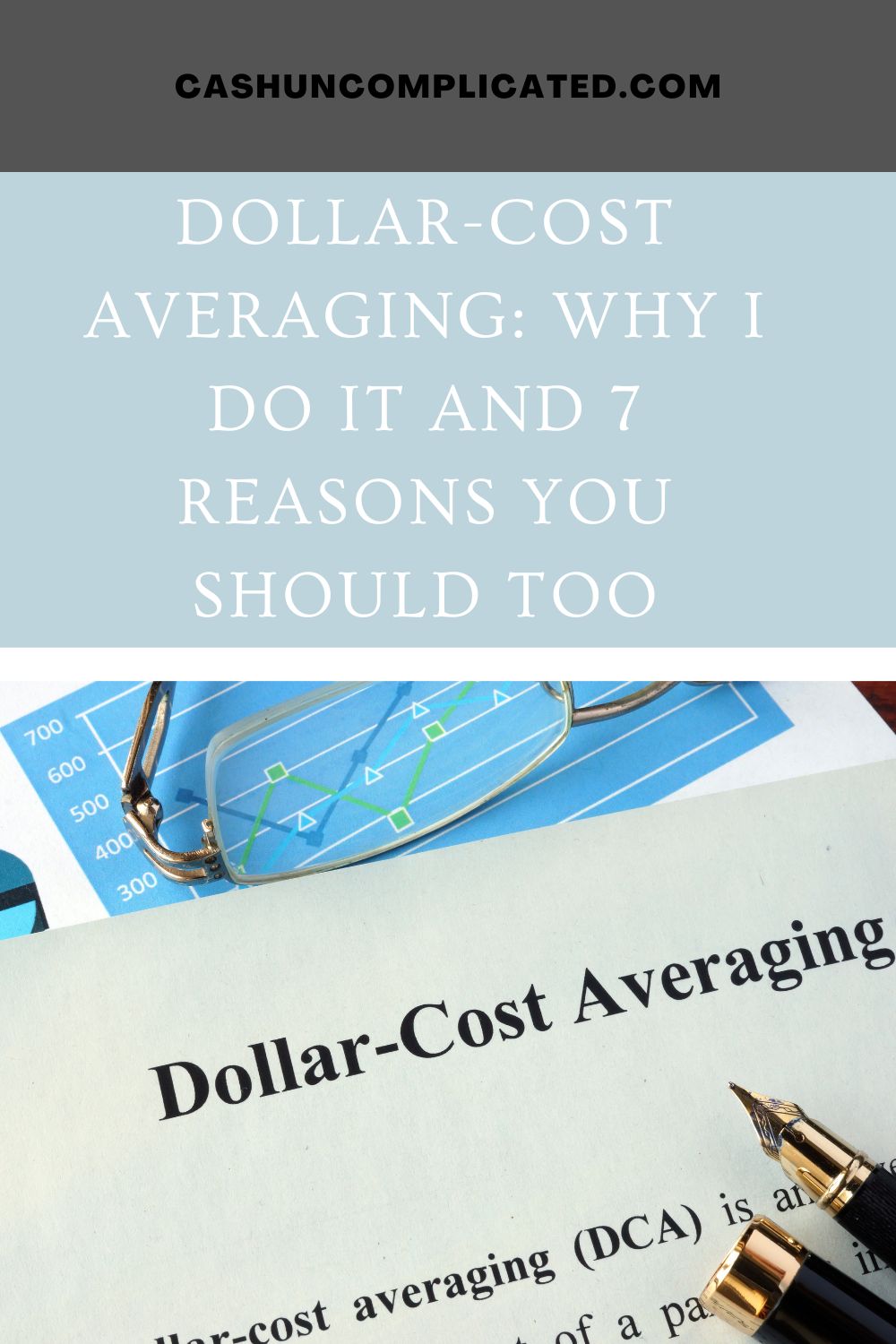Dollar-cost averaging is a strategy I wish I had employed years ago. I don’t remember the exact time I learned about the strategy, but I think it was somewhere between eight and ten years ago. Now, dollar-cost averaging is a big part of my personal finance life and I believe it’s an optimal strategy for the majority of people.
Dollar-Cost Averaging: What it Means
Dollar-cost averaging is the process of consistently investing a set amount of money into some type of investment. It can be index funds, individual stocks, real estate, or any other type of investment. I never recommend specific investments, but I do recommend that everyone invest in something.
Here are a few examples of dollar-cost averaging:
- Sally invests $500 at the start of every month into an index fund
- Jason invests $250 every paycheck into his 401k
- Theresa sets aside $1,000 per month to buy real estate. When she has enough for a down payment, she purchases a property.
What If I Don’t Dollar-Cost Average?
There are plenty of people that don’t participate in dollar-cost averaging. I personally believe there are lots of ways to win in personal finance. I also believe that dollar-cost averaging is one of the best ways (if not the best) to win for the average person.
There are people who believe they can time the market and they pull their money in and out of the market. Some have great success doing it, some do well for a period of time before failing big, and others don’t do it well at all.
I think the majority of people don’t do it well. Personally, I don’t think I do it well at all, so I stick with dollar-cost averaging.
Then there are those who don’t really have a plan at all. They invest from time to time, lack consistency, and jump from one thing to another. Of course someone doing this may get lucky and pick a blue chip stock now and then, but the odds are against them.
Many people going this route actually end up buying high and selling low, the exact opposite of what a successful market timer would do.
Benefits to Dollar-Cost Averaging
There are countless benefits to dollar-cost averaging. Rather than create a list of hundreds of reasons, I’ve narrowed it down to seven really good ones that are easy to understand. This is of course a limited list and anyone reading this would be able to add lots more to it.
Number 1: Consistency
There is great power in consistency. Doing the same thing month after month with your money seems boring, but it’s incredibly powerful. Especially when a time-tested strategy like dollar-cost averaging is employed. Look at these examples:
- A person investing $500 per month at a 10 percent rate of return would have over a million dollars after 30 years.
- An investor who sets aside $1,000 every month at a 10 percent rate of return would net almost six million dollars after 40 years.
- A recent college graduate who begins investing $300 per month after graduation would have well over two million dollars at traditional retirement age, assuming a 10 percent rate of return.
None of these examples are particularly exciting: find a solid investment and consistently contribute to that investment for an extended period of time. That’s it.
No get rich quick, no overnight success, no broke to billionaire in a week. Just consistently following the time-tested principles for years on end.
Number 2: Don’t Have to Time the Market
Spend any amount of time online and you’ll probably see at least a couple clickbait ads for how to successfully time the market. Why now is the best time to buy stocks in the history of the world, the foolproof way to win every time with real estate, how such and such got rich predicting the 2008 crash, etc.
While there are certainly clues about investments going one way or another, it’s never 100 percent. And even if you time the market right, you have to get it right twice: when to get out and when to get back in. Missing the timing on any of these two things is a problem and a good way to lose money.
I’m someone who believes that most people can’t time the market. I’m sure some people do have the ability, but I’m not one of them. So for me, I stick with dollar-cost averaging. That means I don’t need to time the market–I’m going to invest no matter what.
The one constant though is that I will be always investing. I’ll be investing in bull markets, bear markets, transitioning markets, and everything in between.
Warren Buffett famously said: “If you are not willing to hold a stock for 10 years, do not even think of owning it for 10 minutes.” I translate this quote/principle to any type of investment that I hold, it doesn’t have to be stocks. It’s equally applicable to real estate, bonds, index funds, individual stocks, etc.
Number 3: Easy to Automate
The third reason I participate in dollar-cost averaging is that it’s easy to automate. I can contribute a certain amount every month to an investment and it’s done with. The money is taken from my account and moved to an investment.
The money is now an investment, it’s not for me to spend on something else or use for a vacation. The money is working for me and I learn to live off the remaining money in my account. After a few months it becomes second nature and I don’t really give it another thought.
Dollar-cost averaging combined with automation is a very powerful process. It’s definitely not a get-rich quick scheme–but over time it really works and allows for massive compounding.
Here’s an example: Jim automates $500 per month into an investment that yields an average of 10 percent. He continues this strategy whether the market is up or down. After five years he has $40,294. Not life changing money, but nice to have.
However, after 30 years he would have $1,085,661. Of course inflation needs to be factored in, but that’s a nice sum of money. And if he remains consistent for 40 years, the money balloons to $2,921,111. Who knows if that will be a large sum of money in the future, but I guarantee I’d much rather have almost three million dollars than nothing.
Related: Money Buckets: How I Allocate My Monthly Income
Number 4: Power of Compounding
The fourth benefit to dollar-cost averaging is a perfect follow up to number three. Dollar-cost averaging allows the consistent person to benefit from the miracle of compound interest. Yes, there will be down years in whatever investment(s) you choose.
There may even be several years where your investments are down. But over time, history tells us that invested money will compound. You’ve probably seen the disclaimer that past performance is not indicative of future results. Which is true, because nobody can predict the future or what is going to happen.
However, past performance is probably the best clue we have to what the future will hold. Of course it’s not 100 percent, but it’s a better predictor than any other information I have or have heard other people talk about.
Here are a few examples to demonstrate the power of compounding. All examples assume a 10 percent rate of return.
- $300 invested per month for 30 years equals $651,396
- A lump sum of $50,000 invested for 30 years equals $872,470
- Someone investing $2,000 per month for 30 years would have $4,342,642
Your situation is going to look different than these examples. You may be investing a lot less or a lot more. What remains the same though is the power of compound interest and one of the best ways to achieve this super-growth is by dollar-cost averaging.
Number 5: Long-Term Wins
Dollar-cost averaging is geared towards the long term wins. Looking at real estate and stock market data (this is not an investment recommendation, just an example) for the last 50 to 100 years, both investments had periods of time where they were up and down. The ups have been greater than the downs though and anyone investing in either category made great returns.
For example, someone who purchased index funds or real estate in 1980 would have seen tremendous asset appreciation. Same for someone who invested in 1990, 2000, and 2010. Even though there were down periods in between, the gains ultimately far outpaced the losses.
There’s an understanding from those who engage in dollar-cost averaging that the markets will go up and down. The strategy is to keep investing with the idea that they will get a long-term win by staying the course.
Dollar-cost averaging is not good for the short-term though. That’s why it’s very important for people who want to dollar-cost average to resist the temptation to pull money in and out of their investments.
Case in point, someone who began investing last year at this time would have seen losses over a one-year period. But over a 10-year plus period, they are very likely to see gains. Pulling money in and out is more speculation than dollar-cost averaging.
Number 6: Alignment With Life Goals
Most people are not personal finance experts. The majority of us live busy lives filled with work, exercise, kids, hobbies, side hustles, various life responsibilities, and much more. There is not an abundance of time to become an expert in personal finance and investing.
Dollar-cost averaging increases the odds of success for people who want to invest without having to become experts. Yes, it’s highly beneficial to learn the basics of personal finance and investing, but dollar-cost averaging doesn’t require an expert level of knowledge. The basics will do just fine for most people.
Using dollar-cost averaging as a strategy allows more time to focus on other things like kids, the family, friends, health, hobbies, etc. The investment piece is taken care of enough where time and consistency will most likely make up for market drops, recessions, inflation, etc. Of course, as mentioned earlier, there is no guaranteed success–but chances are good based on historical data.
Number 7: Works With Different Investment Types
Dollar-cost averaging is not limited to just one type of investment. Most investments do well with time–and time is on the side with the investor who dollar-cost averages. Dollar-cost averaging assumes a long time in the market in conjunction with consistency.
A few examples of time and consistency
- 22-year old just out of college who invests $200 per month for the next 30+ years
- A 30-year old who just had their first child invests $500 per month for the next 25 years
- Middle-aged person in their early 40’s who began their investing career late invests $1,000 per month for the next 20 years
Even though these investors started at different periods of their life, all of them are following the same principles of dollar-cost averaging, consistency, and using time as an ally. There are many investment options that will work for someone following these principles.
Conclusion
Dollar-cost averaging has worked for me and I believe it can work for everyone. It’s time-tested and doesn’t require an expert level of knowledge. It’s a perfect strategy for the person who wants to invest, but doesn’t want to spend hours each day studying the market.
It eliminates the need for speculation, is easy to automate, and historical data shows a high success rate. There are no guarantees in life–or in investing, but dollar-cost averaging certainly stacks the odds in your favor.











